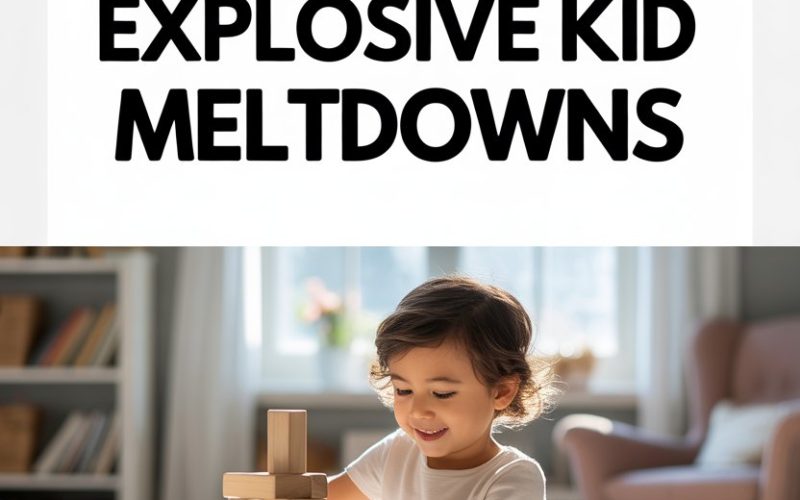Tantrums. Meltdowns. Outbursts that make you question whether you accidentally brought home a tiny, angry tornado instead of your child.
We’ve all been there—sometimes before breakfast. And while you’d love to parent like Mary Poppins, some days it feels more like wrestling a wild chimpanzee.
If you’re searching for tools to stop those explosive moments before you’re knee-deep in a puddle of tears (yours or theirs), you’re not alone.
Here are three tried-and-tested tricks that busy parents swear by, complete with practical moves you can actually use between work meetings and reheated coffee.
1. The Calm Down Code
Wish your child came with an off-switch? Same.
While technology still hasn’t delivered on that particular dream, what does exist is a simple pre-agreed code word or gesture you can use together to signal when things are getting too heated.
Here’s the gist: Pick a word, phrase, or even a silly hand signal together with your child during a totally peaceful moment (perhaps during a civilised breakfast—ha). “Pineapple,” “pause,” or even “elephant dance” work nicely.
The key is that it’s chosen together and feels safe—not shaming or punitive.
When you (or your child) sense a meltdown brewing, use the code. It’s a gentle nudge that it’s time to hit pause and take a breather, rather than powering through the emotional equivalent of a hurricane.
Child psychologist Dr. Laura Markham has written on the power of calm signals and how they can help children feel respected and in control.
The goal is to interrupt the chaos before panic sets in, giving everyone a chance to reset.
If your child is very young or loves a bit of drama, you might act out the code word together—think “statue” where everyone freezes, or “turtle” where you both pull your hoodie over your head.
The sillier, the better, honestly. Laughter can help diffuse tension, and the shared ritual makes your child feel like you’re a team, not adversaries.
Try this tonight: After dinner, talk about tricky moments and brainstorm a code word or gesture together. Make it fun and practice using it a few times when no one is upset.
By the time the next eruption is rumbling, you’ll both have a secret weapon.
2. The Five-Minute Sensory Reset
Ever felt like running away to a spa for a week? Children feel that urge too—except, lacking spa access, they opt for a spectacular floor performance in the supermarket aisle.
This is where sensory resets come in. When kids are overwhelmed, their nervous system often needs something physical to help them shift out of meltdown mode.
Sensory tools aren’t just for children with diagnoses like autism or ADHD; research shows all young people benefit from sensory regulation strategies.
Quick wins include a squishy stress ball, a soft blanket, noise-cancelling headphones, or even chewing crunchy snacks like crackers or apples. Anything that safely engages their senses and interrupts the emotional spiral.
If you’re out and about, try “smell the flower, blow out the candle”—a classic breathing exercise disguised as play. Hold up a finger as the “flower” and another as the “candle.”
Breathe in slowly (smelling the flower), then breathe out (blowing out the candle). Repeat a few times. This hack has been recommended by occupational therapists for years and helps switch off that fight-or-flight response.
Older kids might appreciate a playlist of calming songs, or even a few minutes with sunglasses in a quiet spot. At home, set up a “cosy corner” or “chill-out zone” with soft pillows, books, and fidget toys.
Not a punishment, but an invitation to self-soothe.
Tonight’s challenge: Put together a small “calm kit” together with your child—fill a box or bag with their favourite sensory items. When tempers start to simmer, hand it over with a wink.
Even five minutes can make the difference between a meltdown and a manageable moment.
3. The Connect and Narrate Move
When all else fails—when your child is mid-yell and the dog is hiding under the couch—sometimes, the only way out is through. Enter connection and narration.
Here’s how it works. Instead of trying to “fix” or talk your child out of their feelings (spoiler: this rarely works), sit near, use a calm voice, and put words to what’s happening.
“Your face is red and your fists are clenched. You’re feeling really upset that it’s time to turn off the TV. That’s so hard.” Stay present, but don’t problem-solve yet.
Validating emotions—even when they seem impossibly dramatic—helps kids feel seen, and current brain science supports this. Dr. Daniel Siegel calls it “name it to tame it,” as naming emotions can literally help calm the brain’s alarm bells.
Now, this isn’t about being a doormat or letting your child get away with walloping the cat. Boundaries still matter.
But showing that you can handle big feelings (without matching them yell for yell) teaches your child that emotions are safe, even when they’re huge.
Many parents worry this means “rewarding bad behaviour.” In reality, you’re teaching emotional literacy, which pays off big time over the years. Once your child feels heard, solutions and apologies are far more likely to follow.
Sometimes, you may need to say, “I’m going to keep us both safe right now. I’ll be right here when you’re ready,” and wait it out.
Stay close, stay calm, and breathe. (Tip: If your own inner volcano is about to blow, a quick trip to splash cold water on your face never hurt.)
Tonight, after lights out, talk with your child about how all feelings are okay—even the messy ones.
Let them practice “narrating” a moment from their day, and try modeling it yourself the next time you have a mini meltdown over your phone charger going missing. It’s all about practice.
Raising Calm Kids—Without Losing Your Marbles
If only children came with an instruction manual (or at least a mute button for public tantrums). Parenting is messy, loud, and imperfect, but you’re not powerless against the big feelings that threaten to swallow your day.
With a shared calm-down code, a trusty sensory reset, and a willingness to connect—even in the eye of the storm—you’ll start to see fewer explosions and more moments of calm.
Sometimes the real magic isn’t in stopping every meltdown, but in showing your child they’re never alone, even when their world feels upside down.
And if all else fails? There’s always chocolate.
For you, not them. You’ve earned it.





